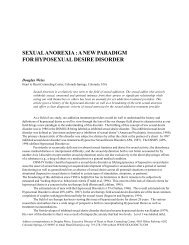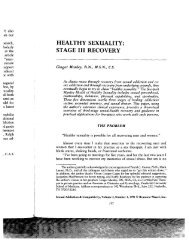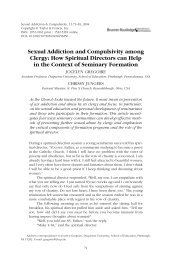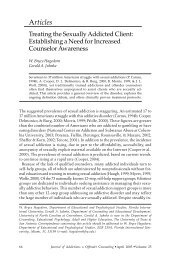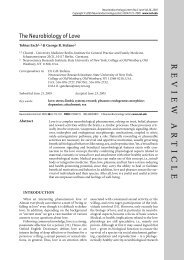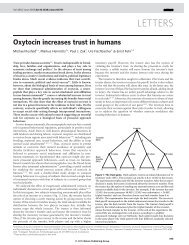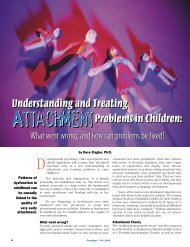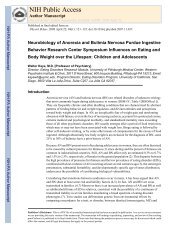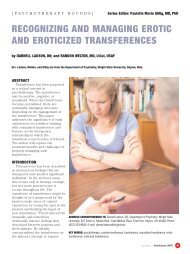CALIFORNIA<strong>Coverage</strong> Trigger & Number ofOccurrencesWhere a child care worker’s husb<strong>and</strong> molested three children overa period of many months <strong>and</strong> the policy provided that “repeatedexposure” to the same “general conditions” is one occurrence, thecourt found that there was one occurrence for each child that wasabused. State Farm Fire <strong>and</strong> Casualty Co. v. Elizabeth N., 12 Cal.Rptr. 2d 327 (Cal. Ct. App. 1992).Where a foster parent negligently failed to stop her husb<strong>and</strong> frommolest<strong>in</strong>g a child over a three-year period <strong>and</strong> the policy providedcoverage for “act(s), errors or omissions . . . occurr<strong>in</strong>g dur<strong>in</strong>g thepolicy period” with limits of $500,000 each claim, the court found therewas $1.5 million <strong>in</strong> <strong>in</strong>surance coverage available. National Union FireIns. Co. v. Lynette C., 33 Cal. Rptr.2d 496 (Cal. Ct. App. 1994).Intentional Acts ExclusionsPerpetrator:Non-perpetrator:<strong>Sexual</strong> <strong>Misconduct</strong> ExclusionsThe California courts have applied the <strong>in</strong>ferred <strong>in</strong>tent rule to <strong>in</strong>stancesof child abuse <strong>and</strong> held there is no coverage for a perpetratorbecause molestation constitutes an <strong>in</strong>tentional act caus<strong>in</strong>g <strong>in</strong>tentionalharm. J.C. Penny Cas. Ins. Co. v. M.K. 278 Cal. Rptr. 2d. 64 (Cal.1991); Quan v. Truck Ins. Exchange, 79 Cal. Rptr. 2d 134 (Cal. Ct.App. 1998); Farmer v. Allstate Ins. Co., 311 F. Supp. 2d 884 (C.D.Cal. 2004); Cf. State Farm Fire & Cas. Co. v. Nycum, 943 F.2d 1100(9th Cir. 1991(Cal.)) (Where allegations did not raise to conclusivepresumption that touch<strong>in</strong>g was <strong>in</strong>tentional child molestation.) Wheredamages are sought for a perpetrator’s sexual as well as separablenon-sexual conduct, an <strong>in</strong>surer may owe a duty to defend. HoraceMann Ins. Co. v. Barbara B., 17 Cal. Rptr. 210 (Cal. 1993).Negligence-based claims brought aga<strong>in</strong>st supervisory defendant areexcluded from coverage if the policy precluded coverage for acts of“any” <strong>in</strong>sured as opposed to “the” <strong>in</strong>sured. See Allstate Ins. Co. v.Gilbert 852 F.2d 449 (9th Cir. 1988); American States Ins. Co. v.Borbor, 826 F.2d 888 (9th Cir. 1987); Farmer v. Allstate, 311 F. Supp.2d 884 (C.D. Cal. 2004).The California courts have generally upheld sexual misconductexclusions. See Farmer v. Allstate Ins. Co., 311 F. Supp. 2d 884 (C.D.Cal. 2004) (no coverage for actions by day care center employeewho sexually abused child or for day care center operator’s negligentsupervision of employee where policy excluded coverage for bodily<strong>in</strong>jury “aris<strong>in</strong>g out of sexual molestation … <strong>in</strong>flicted upon any person byor at the direction of an <strong>in</strong>sured person [or] an employee of an <strong>in</strong>suredperson. …”); Northl<strong>and</strong> Ins. Co. v. Briones, 97 Cal. Rptr. 2d 127(Cal. Ct. App. 2000) (No coverage where <strong>in</strong>structor allegedly raped,assaulted <strong>and</strong> stalked female student <strong>and</strong> policy did not apply to <strong>in</strong>juryaris<strong>in</strong>g out of “physical abuse, sexual abuse, sexual molestation orsexual harassment by anyone. . .”); Jane D. v. Ord<strong>in</strong>ary Mutual, 38 Cal.Rptr. 2d. 131 (Cal. Ct. App. 1995) (No coverage where adult femalewas <strong>in</strong>duced by priest to engage <strong>in</strong> sexual relations dur<strong>in</strong>g counsel<strong>in</strong>g<strong>and</strong> policy excluded “licentious, immoral, or sexual behavior <strong>in</strong>tendedto lead to or culm<strong>in</strong>ate <strong>in</strong> sexual act” because any allegations of nonsexualconduct were “<strong>in</strong>separably <strong>in</strong>tertw<strong>in</strong>ed” with the excludedsexual misconduct); Cf. National Union Fire Ins. Co. v. Lynette C.,279 Cal. Rptr. 394 (Cal Ct. App. 1991), modified on rem<strong>and</strong>, 33 Cal.Rptr. 2d 496 (Cal. Ct. App. 1994) (<strong>Coverage</strong> found for foster motherwho negligently failed to protect foster child from molestation wherepolicy excluded coverage if <strong>in</strong>sured acted with actual lasciviousness orimmoral purpose <strong>and</strong> <strong>in</strong>tent).– 6 –
CALIFORNIAStatute of LimitationsActions for personal <strong>in</strong>juries must be brought with<strong>in</strong> one year. Cal. Civ.Proc. Code §340(3).The California Code was amended <strong>in</strong> 1998 to provide differentlimitations periods for actions brought aga<strong>in</strong>st perpetrators asopposed to third parties. <strong>Claims</strong> aga<strong>in</strong>st perpetrators were requiredto be brought with<strong>in</strong> the later of: (1) eight years of age of majority;or, (2) three years from discovery that psychological <strong>in</strong>jury or illnessoccurr<strong>in</strong>g after the age of majority was caused by the sexual abuse.Cal. Civ. Proc. Code § 340.1(a). <strong>Claims</strong> aga<strong>in</strong>st non-perpetratorswere required to be brought before the claimant’s 26th birthday. Id.at § 340.1(b). See Debbie Reynolds Professional Rehearsal Studiosv. Johnson, 30 Cal. Rptr. 2d 514 (Cal. App. Ct. 1994) (Extendedlimitations period does not apply to third parties); Cf. David T. v. Doe 2,No. E025022 (Cal. App. Ct., 4th Dist. Division 2, April 11, 2000) (courtreached contrary result to Debbie Reynolds decision).The California Code was amended aga<strong>in</strong> <strong>in</strong> 2002. Theseamendments extended the limitations period for claims aga<strong>in</strong>st nonperpetratorswho knew or had reason to know of unlawful sexualconduct by an employee <strong>and</strong> others <strong>and</strong> failed to take steps to avoidacts of further unlawful conduct by that person to eight years aftermajority or three years after discovery that <strong>in</strong>juries were caused by theabuse. Id. at §340(a) <strong>and</strong> (b). These amendments also provided thatclaims which could now be brought aga<strong>in</strong>st non-perpetrators, but wereotherwise barred as of January 1, 2003, were revived if commencedwith<strong>in</strong> one year of January 1, 2003. Id. at §340(c).The California courts have addressed the application of the repressedmemory rule. See Lent v. Doe, 47 Cal. Rptr. 2d 389 (Cal. Ct. App.1995) (Failure to connect abuse to <strong>in</strong>juries was reasonable given thetrauma caused by the abuse); Tietge v. Western Prov<strong>in</strong>ce, 64 Cal.Rptr. 2d 53 (Cal. Ct. App. 1997).Report<strong>in</strong>g LawsOtherCal. Penal Code §11164 et seq.The California courts have generally not allowed vicarious liability.John R. v. Oakl<strong>and</strong> Unified M<strong>in</strong>or School District, 256 Cal. Rptr. 766(Cal. 1989) (School District not vicariously liable for molestation ofstudent by math teacher); Jeffrey v. Central Baptist Church, 243Cal. Rptr. 128 (Cal. Ct. App. 1988); Rita Milla v. Roman CatholicArchbishop of Los Angeles, 232 Cal. Rptr. 685 (Cal. Ct. App. 1986)(Priests’ sexual contact with 16-year-old was not an act performed<strong>in</strong>cident their priestly duties.) However, a trial court recently refusedto summarily dismiss claims alleg<strong>in</strong>g vicarious liability <strong>in</strong> sexual abusecases f<strong>in</strong>d<strong>in</strong>g that the issue of whether the perpetrator’s abuse waswith<strong>in</strong> the scope of employment is a question of fact to be determ<strong>in</strong>edon summary judgment or trial based on the facts of the <strong>in</strong>dividual case.The Clergy Cases III, Judicial Council Coord<strong>in</strong>ated Proceed<strong>in</strong>g No.4359 (Cal. Super. Ct. Alameda Cty. Sept. 24, 2004).– 7 –



